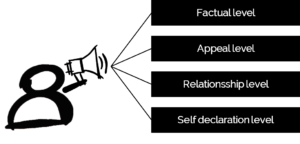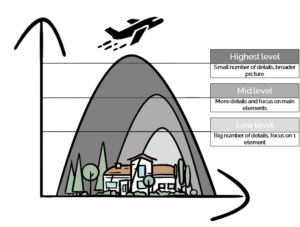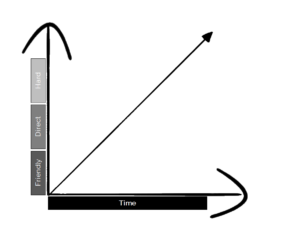Summary
The article describes some of the basics of communication. It ensures, that general rules apply to models compliant with the 80/20 rules. The article does not give methods and descriptions for communication word by word, so is not a communication 101.
This post is also available in:
 Deutsch (German)
Deutsch (German)  polski (Polish)
polski (Polish)
1. Context – Importance and methods of communication
We communicate with our bodies, we communicate with our voice, we communicate even not being at a place at all (see: butterfly effect). It’s our stories, that we tell, when we meet other people, when we motivate other people. Our stories will be told over and over again and will gain impact.
Communication is everything.
But what is communication. Many people know the 93% rule, which says, that a message is send via non-verbal communication for 93%. Many coaches, mentors, trainers etc. cite and present it, when holding communication trainings. Even one of my first communication trainers in adult life believed this is true. Well, as often with scientific work, especially in laboratory setting, it does happen in very specific circumstances.In the case of the 93% rule, where 7% of the message is send via verbal communication, 55% via body language and 38% via tone of voice, both experiments where conducted under the premise, that the verbal and non-verbal signs are not congruent.
This means, that a verbal message is being sent out, while the non-verbal message sends an opposing message. Then the verbal message is “questioned” by the receiver (well, yes! If you say “yes, i want to buy this car”, while crying and avoiding to hand over the money, one might think, that there is something suspicious about your willingness to buy the car. True!)
Furthermore, only 2 experiments where conducted on the issue. Within the scientific world “facts” are accepted as facts, after multiple replication of the results under similar circumstances are registered.
The experiments conducted by A. Mehrabian are not accurately applicable to real world communication situations and are not applicable to situations, in which verbal and non-verbal channels send out congruent messages.Still, it is very important, to understand, that we as humans do have a big eco system of communication channels, such as our facial expressions, our body movement, our gestures, our voice and our spoken words. Often, we should try to get them aligned, in order to communicate a powerful mesage.
2. Conflict – Communication methods are ineffective, if basics are unknown
In order to communicate a congruent message and increase speaking and argumentation effectiveness, there are certain ways and methods. Methods are tought in practical trainings. Often it is forgotten, to teach the basics. Basics in general allow to spontaniously change plans, even if the learned practical method does not support it initially- The following information will therefore focus on basic knowledge. Basic knowledge should fullfil the 80:20 rule and help in making a big step in development.
3. Climax – Some basics should help to navigate
In the following, some basic concepts will be presented, which should help to adjust and improve communication in everyday life.
3.1. A systematic approach
3.1.1. The communication square by Schulz von Thun
A basic system showing on which level we communicate is the communication square by Schulz von Thun. He describes 4 levels, on which we communicate and send out messages.

* The factual level: What topic i am talking about, which reasons do i have, which examples do i show?
* The appeal level: What is my goal within my relationship with the other person, what am i expecting, what are my wishes?
* The relationsship level: How do i perceive the other person, how do i create a positive atmosphere, how is our relationship?
* The self declaration level: What i am showing about myself, how do i perceive the situation, which feelings do i have, which needs do i have?
The receiver of the communication does use the same levels of communication, when receiving messages.
This modell helps in understandning what and when you are communicating. It should help to have an insight on communication not just being spoken words.
3.1.2. The communications-Modell by Prakke
Within the communicationsmodell by Prakke communication is understood as a two way street. Sender and receiver are exchanging information and switching roles the whole time. Both use a specific signs in order to send messages. The sign system might overlap or might not overlap. When the system overlaps, communication is easer. When it does not, communication becomes more difficult.

Both use specific channels for communication. In best case both use the same channel, so that communication is send and received properly. Communication might have different quality. There is the case of information exchange, which is more factual. Then there is the case of commenting information, which is more a subjective evaluation. Then there is a simple conversation, which includes all elements.
This modell helps in understanding, that there is always a receiver and simultaniously a sender on the other side. A good method to better understand the receiver is dissociation in a psychological sense. It means, that one detaches him- or herself from the self experience and is then able to connect with the experience of somebody else, virtually.
3.2. Some basic rules
3.2.1. Top to bottom or the flight height
One of my supervisors always tells me to argue on the highest possible level. What he means, is that the higher a plane is flying, the smaller the world underneath it is and the less details are visible. So what you do is, that you start at the highest possible level, describing a picture with the least possible details.
With each line of argumentation, the flight height decreases and makes more details visible. After reaching the lowest flight height for one argument, one should jump back to the highest point of view, in order to start the next argument.

* Highest level: I see the whole landscape including trees, bushes, a house
* Mid Level: I see the whole house and some of the trees. The house seems to have windows
* Low Level: i see a part of the house. I know, that there are 4 windows. I do see 4 trees.
3.2.2. Build logical chains
This rule is very simple and lets the mind of the listener follow, what is being actually said. It can be described as a mathematical rule.
If A equals B and If B equals C, then A equals C. So what you should do: Don’t start with describing the connection between A and C, but start with AtoB and BtoC, because the connection between A and C will then become self evident.
By building such logical chains, people will be able to follow your argumentation and understand your premisses as well.
Well, do you remember the house of card scene, where Frank Underwood pushed a women under a train? If this scene was shown directly within the first episode, nobody would have understood. First they build up the whole storyline, in order to place the push as an integral part of the development or even the climax of the story.
3.2.3. The cooperative principles (of communication) by Grice
The cooperative principles by Paul Grice, have the goal to communicate more effectively. The principles are the following:
* Maxim of quality: Tell the truth and do not tell things, that under your best knowledge, are false.
* Maxim of quantity: Tell as much as necessary, while telling as little as possible.
* Maxim of relevance: Tell relevant information to the cause. which is pursued by you and your counterpart
* Maxim of manner: Talk precisely and avoid ambiguity.
3.2.4. The FDH-Rule
A general rule, which should especially help in opening conversations, is the FDH Rule, with F being friendly, D being direct and H being hard. It tells a person to be friendly in tone and tough on the matter. When it comes to a timing, then first start with the friendly part, before beginning with the specific toughness on the matter.

One can use a specific scheme for building sentences, in order to introduce the FDH rule into speaking habits:
First be kind and repeat the argument of the opposite site, evaluating it as a very good idea. Then continue by “furthermore”, placing your own argument on top of the previous one.
Such a sentence might sound like: “Well, your idea is a very good approach to solve our issue and furthermore i would suggest to…..”
3.2.4. Positive formulation by Shazer
This might sound like an old rule and might be one of those rules, which trigger the “yeah, i already know this” reaction. But when training positive formulation, it will become obvious pretty soon, that it is not as easy as it seems.
The idea of formulating stuff in a positive way impacts the cognitive thought proccesses, as one has to think first about solutions, that are possible and not about the impossible. Thinking of solutions is a much harder task, than denying something.
Some examples:
* Negative: We are closed from 3pm -> Positive: We are opened until 3pm.
* Negative: We can’t do such a project -> Positive: What we can do in such a case, is…
* Negative: This is impossible -> Positive: What i can offer you, is…
3.2.4. The “boiled frog” or “planted seed” idea
Well, this might not be the most ethical metaphor for an communication mechanism, but the boiled frog is a very simple, but at the same time very powerful mechanism. What happens if a frog is put directly into boiled water?
Well, the frog will jump out and jump away. No frog to eat, today. What is the solution? Well, put the frog into cold water and then slowly boil it up. It will lead to the frog feeling secure and warm. The frog will stay until he’s boiled.
What does this mean for communication? Don’t put all the hard truth on the table immediately. Build up the argument step by step, even by dividing the communication into different moments in time.
One of my colleagues says, that you should plant the seed, take care for it and then harvest the gain. The idea of planting a seed is pretty similar, as it does not put all the information on the table at once. It does assume, that effects have to grow over time and it does assume, that you can’t harvest something if it has not grown before.
3.3. Some basic skills
3.3.1. How to feedback
Feedbacking might be a real art, as it is not just telling the truth. Feedbacking is not an end in itself. It should aim at helping to improve the receiver of the feedback. This is why just telling somebody, that the way to solve something is wrong, is wrong. There are many possible issues with just telling somebody, that he or she is doing something wrong. What if the sender’s evaluation is wrong, objectively? What if the sender does not have all the necessary information to evaluate the receivers choices accurately? What if the sender’s evaluation is just subjectively right? What if it is unclear, what a good way to go for the receiver is? What if the receiver is not in the best mood for receiving feedback?
Well, there are many “if”s, which should be considered. A simple rule might help in communicating feedback in a way, that will avoid the “if” questions. A well constructed feedback should look approximately like the following scheme
* Objective description of the situation: Do only speak about facts. Example: “3 days ago, i have send you an email. My inbox did not show any answer until now”
* Subjetive perception of the situation: Do speak about what you think happened: “Well i have the feeling, that you have not answered, yet. But i am not completely sure.”
* Subjective evaluation of the situation: Do speak about, how you feel about what happened: “For me it is very dissapointing, given the case, that i have not received an answer, yet. It is dissapointing, because i need this information to proceed with the project”
* Communication of target state: Do formulate a state, which would be acceptable for all parties: “Within our common project, we need daily feedback loops in order to not hold on project progress. No matter who is responsible for the next step, the whole team should take care of progress”
* Proposition of next steps: Do formulate a next step, which includes all parties: “Maybe we can exchange information daily for 5 minutes, so that we both do not miss on next steps. This would eliminate the “whom to blame question” from such a situation”
3.3.2. Basics in verbal communication
Some communication skills might help in better understanding of the person on the other side and therefore leading a senseful conversation.
* Asking open questions: Open questions are questions, which allow the other party to evaluate in whatever direction he or she thinks is right. Closed questions in general generate defensive answers and Yes/No answers. Open question: “Where do you want to go?” Vs. Closed question “Should we go to the cinema or to the restaurant?”
* Paraphrasing: Is rephrasing, what the opponent as said in own words. Often it is used to shorten long claims and provide a feeling of understanding.
* Clarifying: Clarification is used in order to confirm rightful understanding and not build the following conversation on false premisses.
* Summarizing: Summarizing is used in order to get acceptance after one topic is discussed and cooperation is reached, in order to proceed with the next topic.
* Mirroring of emotionality and affectivity: Mirroring is used to build trust and rapport. It means re-act the body and facial gestures and expressions of the other party.
* Emphasizing on opinions not judgements: Emphasizing on the fact, that ones evaluation is not a given fact, but an opinion
* Inform all parties about assumptions and goals upfront: Sometimes not showing all cards is less valuable. Within a cooperation scenario showing his cards might help in achieving the common goal, as it will avoid conflicts due to misunderstandings.
* Understand underlying assumptions: This point is very important in negotiations, private and professional. It means, that one should not argue the facts on the table, but the underlying assumptions. Sometimes understanding the underlying assumptions, makes the facts understandable.
* Understand triggering situations: Different people have different learned triggers, which make them become emotional and aggressive. It is good to find out the moments, which trigger the opposite site in order to avoid unnecessary problems
* Less defending oneself: This is a point i like very much. When defending yourself, it means that one is in defense position, accepting short term superiority of the opposite site or the argument of the opposite site.
* Understand your own goals upfront: When understanding own goals upfront, it will lead to clearer communication towards to opposite site, which will increase understandning
* Find a better way or place for cooperatoin: Sometimes places trigger people. Sometime a new place or the use of other words lead to better results, true to the motto: “Don’t expect other results, if you don’t change your behavior”
* Active listening: Active listening is observing and listening to the counterpart, re-asking, at moments which seem to be important.
* Asking questions in general: if you expect an answer, then ask a question. Ask the question in such a way, that the counterpart knows, that this is the focus of the conversation. Do not expect people to answer (honestly) on statements without questions.
4. Conclusion – Communication can be improved simply
4.1. Application on work Environment
There are simple suggestions, whch should help in improving the outcome of interactions with others. At work one should always remember, that certain methods or skills, should be used wisely, depending on context. But rules are there to first cover the average, after taking a look at the extremes and exceptions. A coach can assist within the developmental process, can help in building basics by suggesting the right methods for the specific reality.
For example, the appeal and relationship level within Shulz von Thun’s systematic approach, allowed myself to better understand, why the communication with one of my clients (as a consultant in digital marketing) was not properly functioning. It helped me, to see, what i am communicating to him, besides my spoken words.
Working with flight heights helped me to build better presentations and always stick to the main storyline, even if i moved away telling private sub-stories.
Working with logical chains helped me in writing more sturctured emails and getting better responses. Today, i always begin an email with a question, if i expect an answer. Afterwards i provide all the necessary information, to answer an email.
The Feedback scheme, helped me to understand, that my perception is my perception and not a given fact. This then helped me to not sound so aggressive, when having feedback to tell.
4.2. Application on private environment
Well, the best rule for my private life, is the boiled frog rule. What i do today with pretty much each relationsship, when it comes to difficult news. I introduce some light versions of the truth to the person upfront, some days or even weeks upfront.
I am trying to always suggest, that my judgement is my opinion, to not take away the space of the other person to promote his/her judgement on a market-place of ideas. This helps me to not get into confrontation.
Multimedia
This post is also available in:
 Deutsch (German)
Deutsch (German)  polski (Polish)
polski (Polish)

